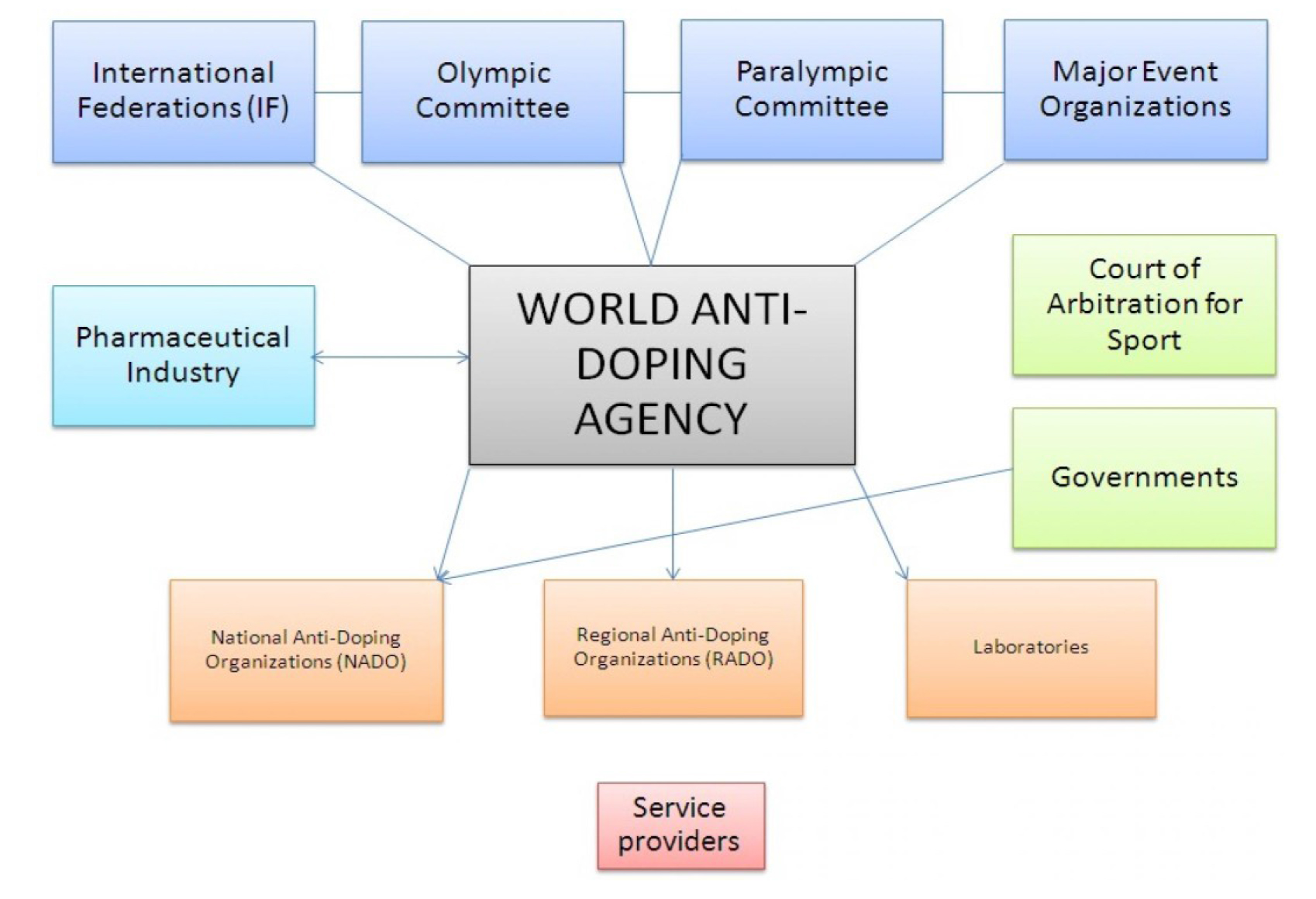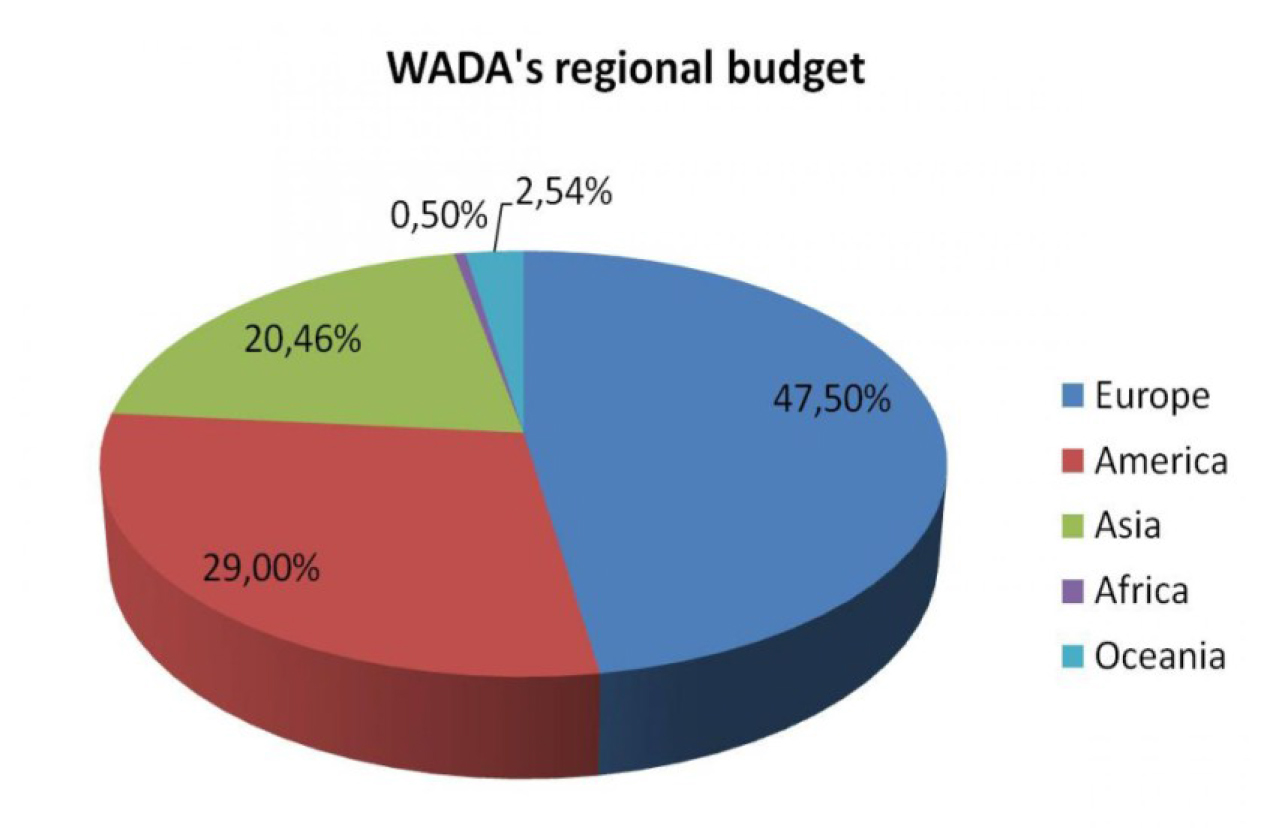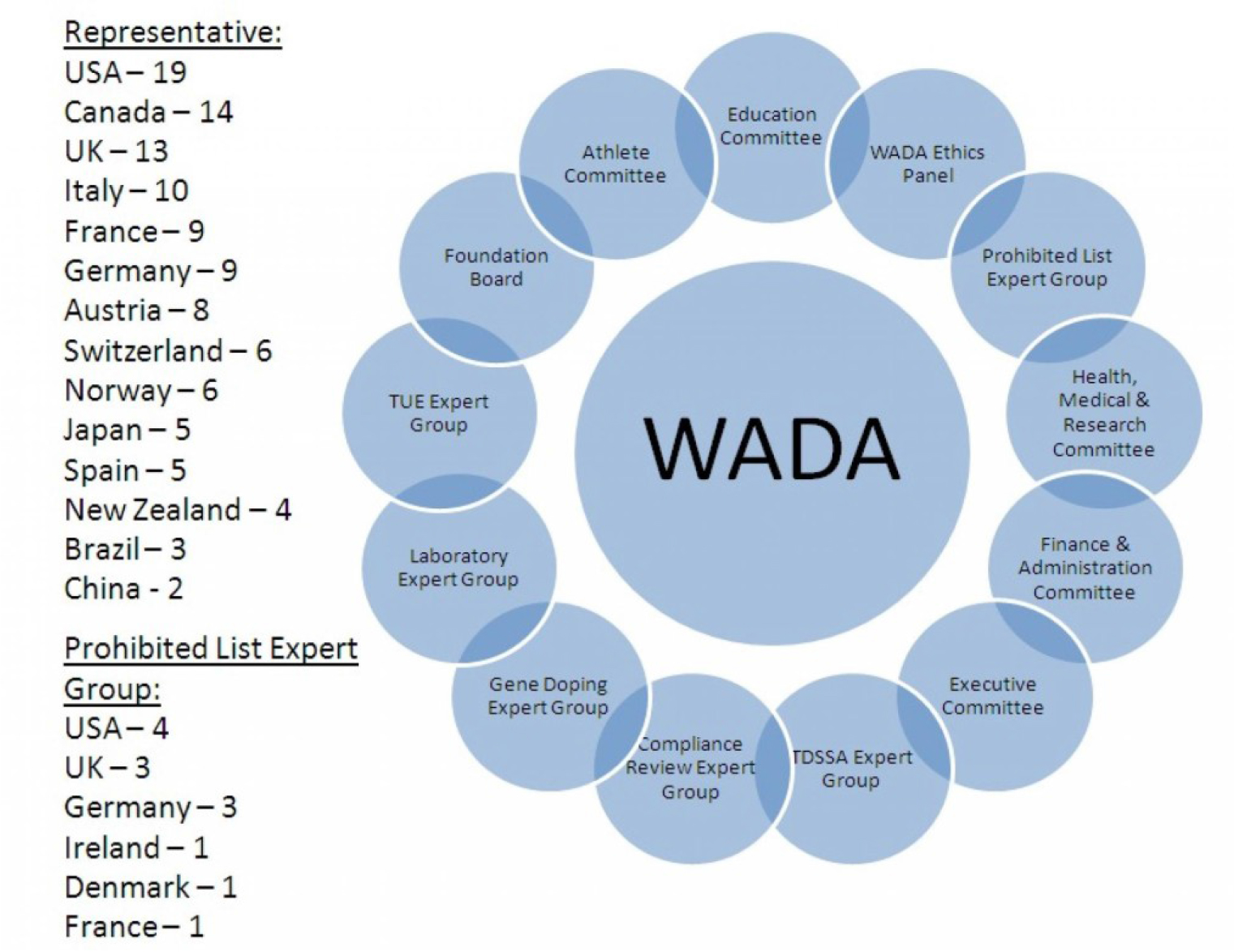World antidoping system design deficiencies and key contradictions with Olympic tenets
Фотографии:
ˑ:
P.I. Lidov1
A.A. Kurbatskaya 1
Y.A. Sukhanovsky1
A.M. Kaziakhmetov1
A.I. Vorobyev1
1Plekhanov Russian University of Economics, Moscow
Keywords: doping, anti-doping commission, anti-doping laboratory, anti-doping agency, WADA, RADA, International Olympic Committee, International Paralympic Committee, Russian Olympic Committee.
Background. Lately the world has seen a series of global events going beyond the field of common and judicial understanding. The leading Russian athletes competing in track and field events and weightlifting [8] and never tested positive by any doping tests were debarred from the Olympic Games in Rio de Janeiro, and similar attempts were made to evict our swimmers, rowers and some other athletes. The hate campaign came to its climax when the disabled Russian athletes never tested positive by doping tests and at the same time symbolising competitive heroism were evicted from the Paralympics. These and other hate actions have clearly shown for the last few months that the cold geopolitical war invaded and occupied the global sports in fact.
It may be pertinent to mention that modern sporting culture is largely organic for a human nature with its domination instinct that urges an individual to demonstrate his/her superiority and win by all means; and in this race many athletes are ready to win by whatever means including the unfair ones [4]. The valid Olympic Charter makes provisions against sport extremism of that kind, with the International Olympic Committee (IOC) and its national agencies empowered to pursue the relevant policies designed to encourage friendship, cooperation and mutual support irrespective of skin colour, gender, faith and political views. In other words, the Olympic Charter may be described as the international sport Gospel which clearly faces the risk of biased revision today [5].
Objective of the study was to analyse the latest actions and conflicts in operations of the World Anti-doping Agency (WADA) that resulted in the present crisis of the global anti-doping system.
Study results and discussion. The existing global anti-doping system implies that an undersigning party must accept and bear responsibility for compliance of the doping-control rules including their initiation, implementation and application in every relevant aspect [1]. The existing global anti-doping system embraces a variety of agencies other than WADA including the IOC and others: see Figure 1.
Figure 1. Global doping-control system
It is the National Anti-doping Organisations (NADO) that are responsible for the doping control activity in every specific country; with a few regional countries often untied in the Regional Anti-doping Organisations (RADO) [16]. It should be noted that national governments and some leading pharmaceutical companies are also ranked among participants of the global doping-control system [10].
WADA was established back in 1999 on the initiative of IOC with support from the relevant bilateral organisations and governments as an international monopolistic agency protected from whatever influences in its doping control operations [3]. As provided by the WADA Statute, the agency may determine on its own the doping test procedures; lists of prohibited medicines; laboratory test standards for bioprobes; it may accredit the relevant anti-doping laboratories; and run the relevant research, informational and education programs.
The WADA financing arrangements were the following. For the first two years of its operation, the agency has been financed by the IOC budget, with the WADA budget estimated at USD 18.3 million. Since 2002 the IOC’ part of the WADA budget was cut down by 50%, with the other part disproportionally funded by instalments of the member nations [14]. However, the geographically and economically disproportional regional budgeting policy and practice of the WADA financing (see Figure 2) resulted in the economical and competitive benefits for some influential nations to the detriment of the others. The major budgeting nations have used the economic levers to impose their authoritarian policies on WADA, and this pressure has resulted in the growing conflict between the Olympic ethics and despotic wilfulness in the doping-control operations.
The financial influence of the specific governments is clearly demonstrated by the distribution of positions in the WADA Foundation Board. 19 of its 38 members represent the global Olympic movement, whilst the other 19 defend the vested interests of the relevant national governments [12]. The WADA operations are controlled by the Executive Committee composed of 6 members representing the global Olympic movement and 6 country members [12]. This national membership principle is further pursued in formation of different WADA committees, commissions and other bodies in charge of one or another field in the global doping control system: see Figure 3. As a result, WADA membership is now dominated by a few leading nations of North America and Europe, whilst China, for instance, is represented by only 2 members; and Russia holding no one position in the WADA system in fact.

Figure 2. WADA’s regional budget, %

Figure 3. National representation in the WADA system
It is the Prohibited List Expert Group that acts as a regulator of the WADA’s doping control operations as it decides what agents must be listed in the Prohibited List – thereby effectively regulating the WADA’s key policies for a few years ahead. Of the 13 Prohibited List Expert Group members, 4 represent the US, 3 the UK, and 3 Germany; with Denmark, Ireland and France holding 1 place each [15]. Neither of Asian, African, Pacific and South American nations is represented in the Group.
Bioprobes are now analysed in 34 WADA-accredited laboratories operating the world over. Paradoxically enough, when probe A is positive with the athlete non-confessing his/her own guilt in doping, no independent laboratory is allowed to analyse probe B, although the WADA’s accreditation is widely known to give no guaranty of total integrity. The chain of withdrawals of the WADA’s licences from accredited laboratories in Russia, Spain, Brasilia, Portugal, China and SAR was due, as provided by the WADA’s reports, to concealments, destructions or substitutions of the doping probes. It is blatantly unfair that, having acknowledged such infringements on the one hand, the WADA still gives no right to the athletes for parallel independent expert tests in other laboratories and, therefore, gives no chance to the athlete to prove his/her innocence when some influential insiders of the WADA system are interested to discredit him/her.
The athlete’ inability to prove his/her guiltlessness may be reasonably interpreted as the WADA-imposed presumption of guilt. Athlete has no way to prove that doping could enter his/her body accidentally, without his/her consent, and with no intention to obtain an unfair advantage in competitions. As a result, an athlete with an unstained reputation may fall victim to doping-terrorism or other unconscious accidental intake of a prohibited agent – and may be not only deprived of the medal but also evicted from the sport for a long time [7]. This is the reason why even the notions of presumption of guilt and doping-terrorism are effectively ignored to turn a blind eye to the growing gap between the anti-doing rules and the key provisions of the valid international legislation. In addition, the presumption of guilt has given rise to the special international arbitration system (CAS) [11]. As things now stand, the CAS is totally independent of IOC and governed only by the WADA’s anti-doping rules and Code; it also falls in conflict with the valid international legislation; and justifies evictions of innocent athletes from sports [9].
Further evidence of the vested interests of the few influential nations is provided by the multiple cases when national athletes have been formally allowed to administer strong stimulators by the relevant Therapeutic Use Exemptions (TUE) in the valid anti-doping laws. The TUE makes it possible for the sick athletes to successfully compete with the healthy ones by applying prohibited agents; and at the same time the TUE gives the way to bypass the anti-doping laws [6] by false medical diagnoses and/or doctored clinical reports. It is the international sport system that opportunistically decides who of the athletes is allowed to make resort to such a “therapeutic service” and who is not. This is how 20 years ago the global sports saw the inflow of “asthmatics” allowed using the prohibited stimulators; later on they were joined by “mentally retarded” athletes allowed using narcotics.
One more indirect indication of the discrimination policies pursued by the world doping control system is the conspiracy of silence about one more loophole for unfair advantage of one athlete over another obtained by application of new agents still non-listed by the Prohibited List. The nation that has produced such a new agent may enjoy at least two four-year periods when the agent or method application is totally unpunished before it may be listed with the Prohibited List. It should be noted that WADA’s operations do not have a slightest chance to catch up with the pharmacological progress. This loophole gives advantage in different sports to the athletes representing the leading pharmacological nations. In view of the WADA system being dominated exactly by the nations that lead in pharmacological production, it is a small wonder that they are disinterested in any steps to liquidate the unfair advantage.
Conclusion. Presently the WADA has evolved to a global monopoly totally dependent on the financial support of a few leading nations. The disproportional budgeting arrangements have resulted in the growing pressure on WADA from a few influential nations and their disproportional membership in the relevant agencies and operations. The anti-doping rules have come into conflict with the international legislation, Olympic Charter and the commonly accepted ethical principles. As a result, WADA is no more regulated by IOC as a spiritual leader and freely pursues its own biased and discriminatory policies. This is the key reason for the global Olympic movement coming to the climax of its crisis. We recommend that the relevant Olympic movement founding organisations should use their founder’s rights as soon as possible to make a fair and serious analysis of the situation and undertake major reforms of the global doping control system on the whole and WADA in particular.
References
- Vsemirny antidopingovy kodeks [World Anti-Doping Code]. Vsemirnoe antidopingovoe agentstvo [World Anti-Doping Agency]. Transl. Engl. A.A. Antseliovich, A.A. Derevoedov. 2015, 161 p.
- Vsemirny antidopingovy kodeks: Mezhdunarodny standart po testirovaniyu i rassledovaniyam []. Vsemirnoe antidopingovoe agentstvo [World Anti-Doping Code: International Standard for Testing and Investigation]. Transl. Engl. RUSADA, 2015, 150 p.
- Derevoedov A.A. Doping v sporte i borba s nim [Doping in sport and fighting it]. Vestnik RMOU, 2012, no. 1(2), pp. 76–85.
- Kulikov E. Sportivny doping: istoriya, predely i perspektivy [Sports doping: history, limits and prospects]. Logos, 2014, no. 3 (99), pp. 223–230.
- Lidov P.I. Kastrirovannye vozmozhnosti WADA: kak MOK i rossiyskomu sportu zalamyvayut ruki [WADA deprived of capabilities: how they wring hands of IOC and Russian sports]. 2016. 19 iyulya. Available at: https://riafan.ru/538425-kastrirovannye-vozmozhnosti-wada-kak-mok-i-ross...
- Lidov P.I. Dopingovuyu voynu protiv nas organizovali SShA [The doping war against us organized by the USA]. 2016. August, 8. Available at: http://www.eg.ru/daily/sports/54402/
- Lidov P.I. Imena poymannykh na dopinge stanovilis predmetom torga i shantazha [The names of athletes caught doping became the subject of bargaining and blackmail]. 2016. October, 11. Available at:http://www.eg.ru/daily/sports/56992/
- Kelnerand M., Harrisand N., Stewart W. Victory in our fight for Russian doping justice: Drugs, bribery and cheating no more investigation triggers official probe. “The Mail on Sunday” 16.11.2013.
- Straubel M. Enhancing the Performance of the Doping Court: How the Court of Arbitration for Sport Can Do Its Job Better. N.Y., 2007, P. 32
- Anti-doping community.World Anti-doping Agency. Available at: https://www.wada-ama.org/en/anti-doping-community
- Court of Arbitration for Sport. World Anti-doping Agency. Available at: https://www.wada-ama.org/en/court-of-arbitration-for-sport
- Governance. World Anti-doping Agency. Available at: https://www.wada-ama.org/en/governance
- Government representation. World Anti-doping Agency. Available at: https://www.wada-ama.org/en/government-representation
- Historical background. World Anti-doping Agency. Available at: https://www.wada-ama.org/en/funding
- Prohibited list expert group. World Anti-doping Agency. Available at: https://www.wada-ama.org/en/prohibited-list-expert-group
- Regional anti-doping organizations (RADO). World Anti-doping Agency. Available at: https://www.wada-ama.org/en/regional-anti-doping-organizations-rado
Corresponding author: u.sukhanovskiy@gmail.com
Abstract
The article analyses progress of the global antidoping system on the whole and WADA in particular to demonstrate the ideological errors made in its design stage and echoed in the presently unfair structure and policies of the Agency. The geocentric design of the WADA makes it possible for the majority nations to effectively lobby their interests in fact. This initial structural distortions further aggravated by the biased practical activities of the WADA largely determined by the vested interests of a few leading nations have resulted in a deep crisis of the global antidoping system, its irreconcilable conflict with the Olympic Charter and a serious threat for the global Olympic movement on the whole – since the economic and political factors of the WADA establishment and operations make it susceptible to political and other pressures in violation of the Olympic principles of equality, integrity and unbiased attitudes – still supported and advanced by the International Olympic Committee.
The raft of deep contradictions in the foundation of the WADA operations and the growing monopolism and impunity have developed the policies of areal and national inequality that lately evolved to the attempted revisions of the global sport legislation in favour of some nations, with regulatory loopholes and exemptions for some nations and closed doors for the others.



